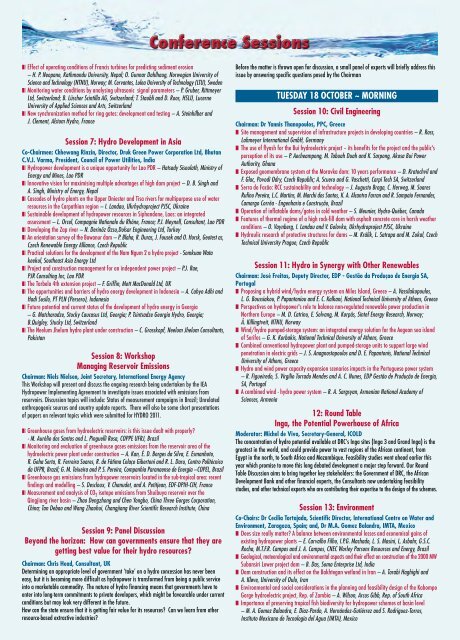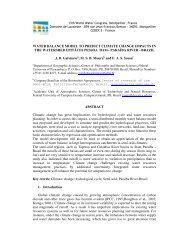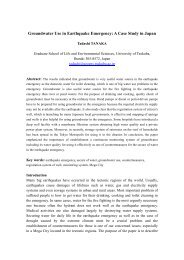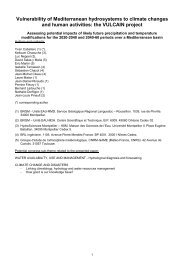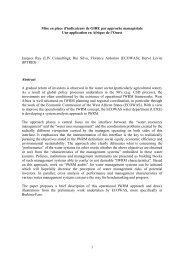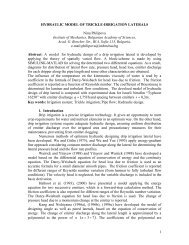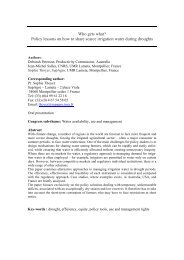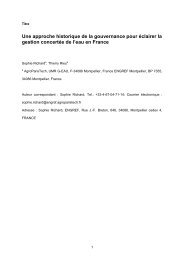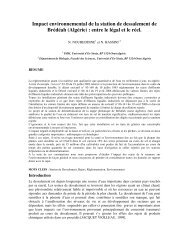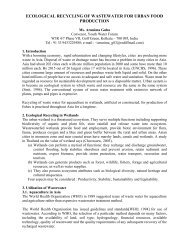Download - IWRA
Download - IWRA
Download - IWRA
Create successful ePaper yourself
Turn your PDF publications into a flip-book with our unique Google optimized e-Paper software.
❚❘ Effect of operating conditions of Francis turbines for predicting sediment erosion– H. P. Neopane, Kathmandu University, Nepal; O. Gunnar Dahlhaug, Norwegian University ofScience and Technology (NTNU), Norway; M. Cervantes, Lulea University of Technology (LTU), Sweden❚❘ Monitoring water conditions by analysing ultrasonic signal parameters – P. Gruber, RittmeyerLtd, Switzerland; B. Lüscher Scintilla AG, Switzerland; T. Staubli and D. Roos, HSLU, LucerneUniversity of Applied Sciences and Arts, Switzerland❚❘ New synchronization method for ring gates: development and testing – A. Steinhilber andJ. Clement, Alstom Hydro, FranceSession 7: Hydro Development in AsiaCo-Chairmen: Chhewang Rinzin, Director, Druk Green Power Corporation Ltd, BhutanC.V.J. Varma, President, Council of Power Utilities, India❚❘ Hydropower development is a unique opportunity for Lao PDR – Hatsady Sisoulath, Ministry ofEnergy and Mines, Lao PDR❚❘ Innovative vision for maximising multiple advantages of high dam project – D. B. Singh andA. Singh, Ministry of Energy, Nepal❚❘ Cascades of hydro plants on the Upper Dniester and Tisa rivers for multipurpose use of waterresources in the Carpathian region – I. Landau, Ukrhydroproject PJSC, Ukraine❚❘ Sustainable development of hydropower resources in Siphandone, Laos: an integratedassessment – L. Orcel, Compagnie Nationale du Rhône, France; P.J. Meynell, Consultant, Lao PDR❚❘ Developing the Zap river – N. Derinöz Özsu,Dolsar Engineering Ltd, Turkey❚❘ An orientation survey of the Bawanur dam – P. Blaha, R. Duras, J. Fousek and O. Horsk, Geotest as,Czech Renewable Energy Alliance, Czech Republic❚❘ Practical solutions for the development of the Nam Ngum 2 a hydro project - Somkuan Watakeekul, Southeast Asia Energy Ltd❚❘ Project and construction management for an independent power project – P.J. Rae,PJR Consulting Inc, Lao PDR❚❘ The Tarbela 4th extension project – F. Griffin, Mott MacDonald Ltd, UK❚❘ The opportunities and barriers of hydro energy development in Indonesia – A. Cahyo Adhi andHadi Susilo, PT PLN (Persero), Indonesia❚❘ Future potential and current status of the development of hydro energy in Georgia– G. Matcharadze, Stucky Caucasus Ltd, Georgia; P. Tsintsadze Georgia Hydro, Georgia;B.Quigley, Stucky Ltd, Switzerland❚❘ The Neelum Jhelum hydro plant under construction – C. Grosskopf, Neelum Jhelum Consultants,PakistanSession 8: WorkshopManaging Reservoir EmissionsChairman: Niels Nielsen, Joint Secretary, International Energy AgencyThis Workshop will present and discuss the ongoing research being undertaken by the IEAHydropower Implementing Agreement to investigate issues associated with emissions fromreservoirs. Discussion topics will include: Status of measurement campaigns in Brazil; Unrelatedanthropogenic sources and country update reports. There will also be some short presentationsof papers on relevant topics which were submitted for HYDRO 2011.❚❘ Greenhouse gases from hydroelectric reservoirs: is this issue dealt with properly?- M. Aurélio dos Santos and L. Pinguelli Rosa, COPPE UFRJ, Brazil❚❘ Monitoring and evaluation of greenhouse gases emissions from the reservoir area of thehydroelectric power plant under construction – A. Kan, É. D. Borges da Silva, E. Esmanhoto,R. Geha Serta, R. Ferreira Soares, R. de Fátima Colaço Gibertoni and R. L. Daru, Centro Politécnicoda UFPR, Brazil; G. M. Teixeira and P. S. Pereira, Companhia Paranaense de Energia –COPEL, Brazil❚❘ Greenhouse gas emissions from hydropower reservoirs located in the sub-tropical area: recentfindings and modelling – S. Descloux, V. Chanudet, and A. Petitjean, EDF-DPIH-CIH, France❚❘ Measurement and analysis of CO 2 isotope emissions from Shuibuya reservoir over theQingjiang river basin – Zhao Dengzhong and Chen Yongbo, China Three Gorges Corporation,China; Tan Debao and Wang Zhaohui, Changjiang River Scientific Research Institute, ChinaSession 9: Panel DiscussionBeyond the horizon: How can governments ensure that they aregetting best value for their hydro resources?Chairman: Chris Head, Consultant, UKDetermining an appropriate level of government ‘take’ on a hydro concession has never beeneasy, but it is becoming more difficult as hydropower is transformed from being a public serviceinto a marketable commodity. The nature of hydro financing means that governments have toenter into long-term commitments to private developers, which might be favourable under currentconditions but may look very different in the future.How can the state ensure that it is getting fair value for its resources? Can we learn from otherresource-based extractive industries?Before the matter is thrown open for discussion, a small panel of experts will briefly address thisissue by answering specific questions posed by the ChairmanTUESDAY 18 OCTOBER ~ MORNINGSession 10: Civil EngineeringChairman: Dr Yannis Thanopoulos, PPC, Greece❚❘ Site management and supervision of infrastructure projects in developing countries – R. Ross,Lahmeyer International GmbH, Germany❚❘ The use of flyash for the Bui hydroelectric project – its benefits for the project and the public'sperception of its use – P. Aecheampong, M. Tabuah Duah and K. Sarpong, Akosa Bui PowerAuthority, Ghana❚❘ Exposed geomembrane system at the Moravka dam: 10 years performance – D. Kratochvil andF. Glac, Povodi Odry, Czech Republic; A. Scuero and G. Vaschetti, Carpi Tech SA, Switzerland❚❘ Serra do Facão: RCC sustainability and technology – J. Augusto Braga, C. Herweg, M. SoaresRufino Pereira, L.C. Martins, M. Marchi dos Santos, K. A. Alcantra Farran and R. Sampaio Fernandes,Camargo Corrêa - Engenharia e Construçäo, Brazil❚❘ Operation of inflatable dams/gates in cold weather – S. Meunier, Hydro-Québec, Canada❚❘ Features of thermal regime of a high rock-fill dam with asphalt concrete core in harsh weatherconditions – O. Vaynberg, I. Landau and V. Golovko, Ukrhydroproject PJSC, Ukraine❚❘ Hydraulic research of protective structures for dams – M. Králík, L. Satrapa and M. Zukal, CzechTechnical University Prague, Czech RepublicSession 11: Hydro in Synergy with Other RenewablesChairman: José Freitas, Deputy Director, EDP - Gestão da Produçao de Energia SA,Portugal❚❘ Proposing a hybrid wind/hydro energy system on Milos Island, Greece – A. Vassilakopoulos,L. G. Boussiakou, P. Papantoniou and E. C. Kalkani, National Technical University of Athens, Greece❚❘ Perspectives on hydropower's role to balance non-regulated renewable power production inNorthern Europe – M. D. Catrinu, E. Solvang, M. Korpås, Sintef Energy Research, Norway;Å. Killingtveit, NTNU, Norway❚❘ Wind/hydro pumped-storage system: an integrated energy solution for the Aegean sea islandof Serifos – G. K. Korbakis, National Technical University of Athens, Greece❚❘ Combined conventional hydropower plant and pumped-storage units to support large windpenetration in electric grids – J. S. Anagnostopoulos and D. E. Papantonis, National TechnicalUniversity of Athens, Greece❚❘ Hydro and wind power capacity expansion scenarios impacts in the Portuguese power system– R. Figueiredo, S. Virgílio Torrado Mendes and A. C. Nunes, EDP Gestão de Produção de Energia,SA, Portugal❚❘ A combined wind - hydro power system – R. A. Sargsyan, Armenian National Academy ofSciences, Armenia12: Round TableInga, the Potential Powerhouse of AfricaModerator: Michel de Vivo, Secretary-General, ICOLDThe concentration of hydro potential available at DRC’s Inga sites (Inga 3 and Grand Inga) is thegreatest in the world, and could provide power to vast regions of the African continent, fromEgypt in the north, to South Africa and Mozambique. Feasibility studies went ahead earlier thisyear which promise to move this long debated development a major step forward. Our RoundTable Discussion aims to bring together key stakeholders: the Government of DRC, the AfricanDevelopment Bank and other financial experts, the Consultants now undertaking feasibilitystudies, and other technical experts who are contributing their expertise to the design of the schemes.Session 13: EnvironmentCo-Chairs: Dr Cecilia Tortajada, Scientific Director, International Centre on Water andEnvironment, Zaragoza, Spain; and, Dr M.A. Gomez Balandra, IMTA, Mexico❚❘ Does size really matter? A balance between environmental losses and economical gains ofexisting hydropower plants – E. Carvalho Filho, I.P.G. Machado, L. S. Masini, L. Asbahr, G.S.C.Rocha, M.T.F.R. Campos and J. A. Campos, CNEC Worley Parsons Resources and Energy, Brazil❚❘ Geological, meteorological and environmental aspects and their effect on construction of the 2000 MWSubansiri Lower project dam – B. Das, Soma Enterprise Ltd, India❚❘ Dam construction and its effect on the Bakhtegan wetland in Iran – A. Torabi Haghighi andA. Kløve, University of Oulu, Iran❚❘ Environmental and social considerations in the planning and feasibility design of the KabompoGorge hydroelectric project, Rep. of Zambia – A. Wilson, Arcus Gibb, Rep. of South Africa❚❘ Importance of preserving tropical fish biodiversity for hydropower schemes at basin level– M. A. Gomez Balandra, E. Díaz-Pardo, A. Hernández-Gutiérrez and S. Rodriguez-Torres,Instituto Mexicano de Tecnologia del Agua (IMTA), Mexico


